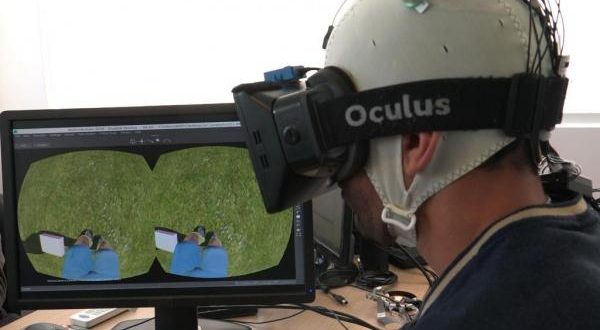Technology is now helping people who have been paralysed for years, and the results are amazing.
Eight people with spinal cord injuries have regained some feeling in their legs after training with brain-controlled robotics, in a result nobody, not even the lead neuroscientist, expected.
Biomedical engineers and neuroscientists from Brazil and the US designed brain-machine interface training using the patients’ brain activity which let them simulate control of their legs.
Several patients saw muscle movement and sensation improvements after only seven months. After a year, most regained some bladder and bowel control too.
The work, which was unveiled in Scientific Reports today, offers promise to patients with spinal cord injuries and other conditions such as stroke to regain strength and control.
When it comes to muscle control, the adage “use it or lose it” certainly applies. Mobile people can usually walk without thinking, moving muscles and joints fluidly and automatically.
But those with spinal cord injuries end up with disrupted signals between brain and legs. The brain areas, then, slowly become dormant and muscles wither and atrophy. Could they be reawakened?
A research team led by Miguel Nicolelis at Duke University in the US, and part of the Walk Again Project in São Paulo in Brazil, wanted to find out.
They recruited eight patients with paraplegia. Five had been paralysed for at least five years; another two subjects for at least a decade.
An electrode cap captured brain activity while the patients watched an avatar, from their point of view, walking in a virtual environment. At first, the parts of the brain responsible for leg movement failed to light up – understandable, given they’d not been used for years.
But after a few months of weekly training sessions, the brain activity seen in mobile people began to pop up in the study participants.
“Basically, the training reinserted the representation of lower limbs into the patients’ brains,” Nicolelis says.
To encourage feeling in their legs, subjects wore sleeves that vibrated, depending on whether the avatar was walking on gravel or grass or sand.
Eventually, the subjects progressed to more challenging equipment, such as harnesses to support their weight and walking devices and a robotic exoskeleton.
In the video below, a 32-year-old woman who’d been paralysed from the waist down for 13 years took step-like motions after 13 months of virtual reality training.
The work reported in the paper is only part of the story. The subjects are now more than two years into their rehabilitation and their progress will continue being published, Nicolelis says.
The team is also designing a new trial to target more recent paraplegia patients to see if it leads to faster or better results.
Agencies/Canadajournal

 Canada Journal – News of the World Articles and videos to bring you the biggest Canadian news stories from across the country every day
Canada Journal – News of the World Articles and videos to bring you the biggest Canadian news stories from across the country every day

